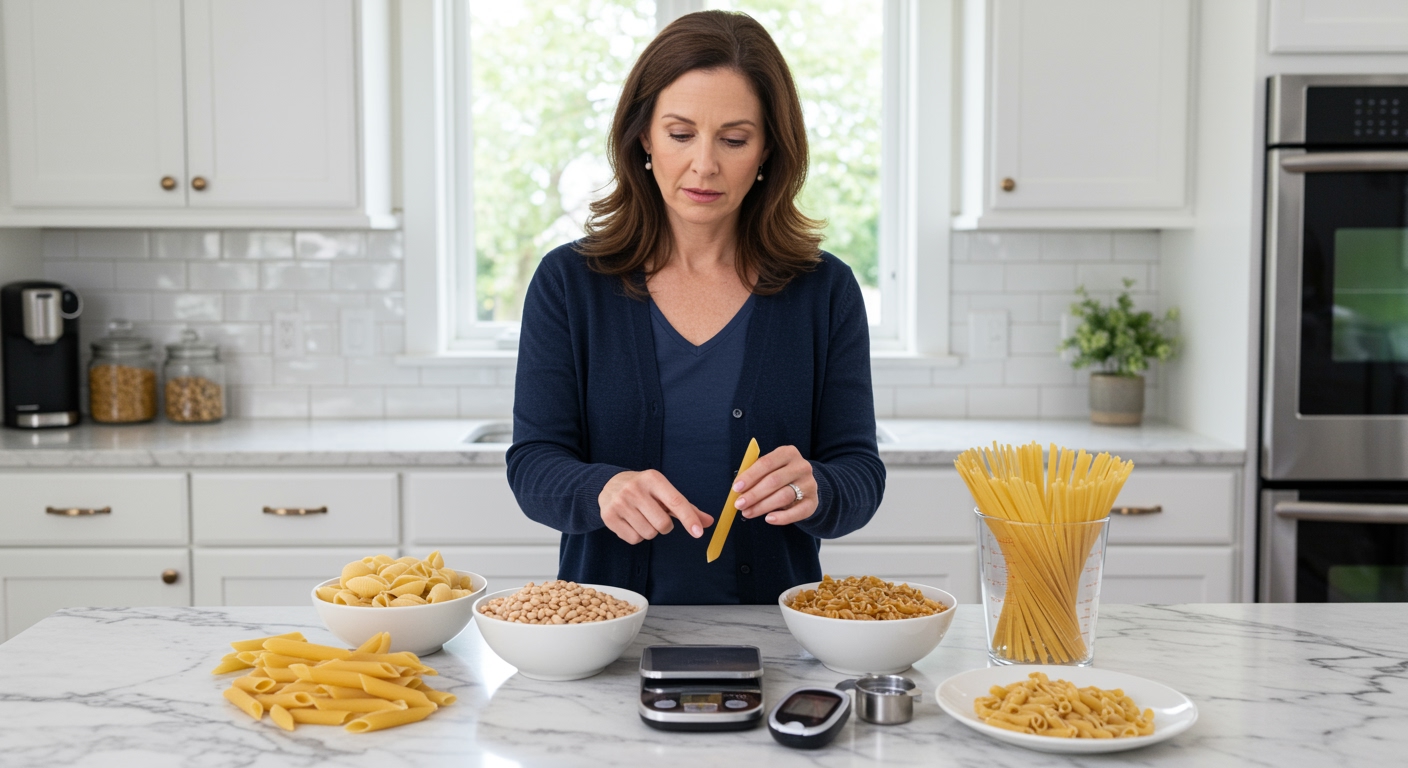✪ Key Takeaway: Pasta can be part of a diabetes-friendly diet when you choose whole grain varieties and control portions properly.
Introduction
You stare at that box of pasta in your pantry and wonder if you should throw it away.
Many people with diabetes believe pasta is completely forbidden because it contains carbohydrates that can raise blood sugar levels.
Hi, I am Abdur, your nutrition coach and today I am going to explain exactly how pasta affects your blood sugar and which types you can safely enjoy.
How Does Pasta Affect Blood Sugar Levels?
Pasta contains carbohydrates that your body breaks down into glucose during digestion.
When glucose enters your bloodstream, your pancreas releases insulin to help cells absorb this sugar for energy.
People with diabetes have problems with insulin production or insulin sensitivity, which makes blood sugar control more challenging.
The glycemic index measures how quickly foods raise blood sugar on a scale from 0 to 100.
Regular white pasta has a moderate glycemic index of around 50-55, which means it raises blood sugar more slowly than white bread or sugary drinks.
However, the cooking method and what you eat with pasta significantly affects its impact on your blood sugar levels.
✪ Fact: Al dente pasta has a lower glycemic index than overcooked soft pasta because the starch structure remains more intact.
Which Types Of Pasta Are Best For Diabetes?
Whole wheat pasta contains more fiber than regular pasta, which slows down sugar absorption and helps prevent blood sugar spikes.
The fiber content in whole wheat pasta is about 6 grams per cup compared to only 2 grams in regular pasta.
Legume-based pasta made from lentils, chickpeas, or black beans provides even more benefits for blood sugar control.
These alternatives contain both fiber and protein, which work together to slow glucose absorption and keep you feeling full longer.
Shirataki noodles made from konjac root contain almost no carbohydrates and can be an excellent pasta substitute for strict blood sugar control.
Even regular pasta can work if you choose the right portion size and pair it with protein and vegetables to balance the meal.
✪ Pro Tip: Mix regular pasta with spiralized vegetables like zucchini to increase volume while reducing carbohydrate content.
What Is The Right Portion Size For Pasta?
Most restaurants serve 2-3 cups of cooked pasta, but the recommended portion for diabetes management is only half a cup to one cup.
One cup of cooked regular pasta contains about 45 grams of carbohydrates, which equals three carbohydrate exchanges in diabetes meal planning.
Your individual carbohydrate needs depend on your activity level, medications, and blood sugar targets set by your healthcare team.
Using a kitchen scale or measuring cups helps you learn what proper portions look like on your plate.
Many people find success using smaller plates and bowls to make appropriate portions appear more satisfying.
Remember that pasta expands during cooking, so 2 ounces of dry pasta becomes about 1 cup when cooked.
✪ Note: Your fist size is roughly equivalent to one cup, making it a handy portion guide when eating away from home.
How Should You Prepare Pasta For Better Blood Sugar Control?
Cook pasta al dente rather than soft because firmer pasta has a lower glycemic index and slower sugar absorption.
Adding healthy fats like olive oil or nuts to your pasta dish helps slow down carbohydrate absorption and improves blood sugar response.
Include plenty of non-starchy vegetables like broccoli, bell peppers, or spinach to add fiber and nutrients while diluting the carbohydrate density.
Lean proteins such as grilled chicken, turkey, or fish help balance the meal and prevent rapid blood sugar rises.
Avoid cream-based sauces that add unnecessary calories and choose tomato-based sauces with herbs and spices instead.
Eating pasta as part of a balanced meal rather than alone significantly improves its effect on blood sugar levels.
✪ Pro Tip: Start your pasta meal with a salad to slow down eating pace and improve blood sugar response through fiber intake.
When Is The Best Time To Eat Pasta?
Eating pasta earlier in the day gives your body more time to process the carbohydrates and use them for energy rather than storage.
Your insulin sensitivity is typically higher in the morning, making breakfast or lunch better times for higher carbohydrate foods like pasta.
If you exercise regularly, eating pasta before or after workouts can help your muscles use the glucose more effectively.
Avoid eating large pasta portions late at night when your metabolism slows down and blood sugar control becomes more challenging.
Monitor your blood sugar levels 2 hours after eating pasta to understand how your body responds to different types and portions.
Keep a food diary to track which pasta preparations work best for your individual blood sugar management goals.
✪ Fact: Physical activity within 30 minutes after eating can help lower post-meal blood sugar spikes by up to 30 percent.
The Bottom Line
Pasta can absolutely be part of a healthy diabetes management plan when you make smart choices about type, portion size, and preparation methods.
The key to diabetes-friendly eating is not elimination but education – understanding how foods affect your body empowers you to make better decisions.
I would love to hear about your experiences with pasta and blood sugar management, so please share your questions, tips, or challenges in the comments below.
References
At NutritionCrown, we use quality and credible sources to ensure our content is accurate and trustworthy. Below are the sources referenced in creating this article:
- Glycemic Index Net: Pasta Glycemic Index Values
- Medical News Today: Diabetic Pasta Recipes
- PMC: Pasta and Glycemic Response Study
- Diabetes Canada: The Glycemic Index and You





